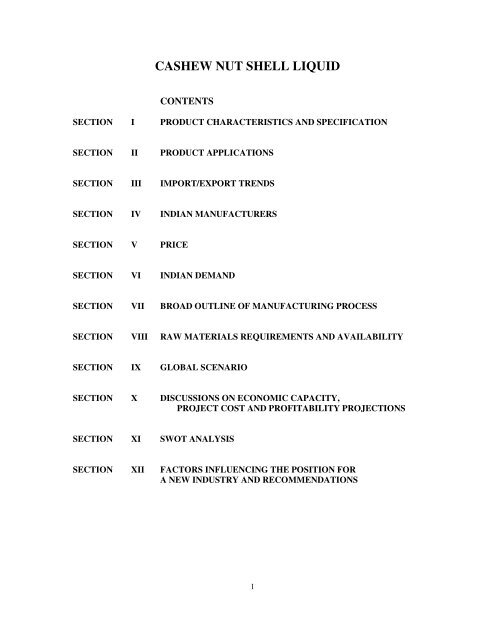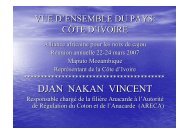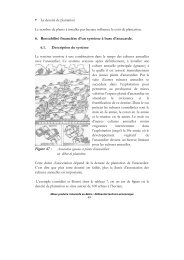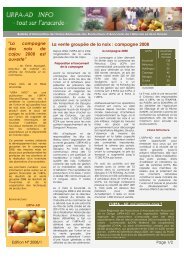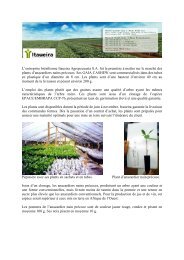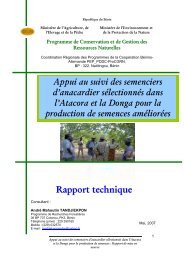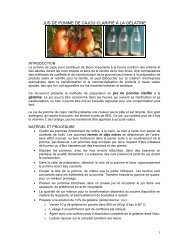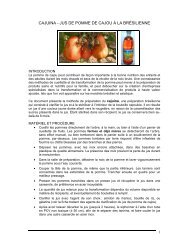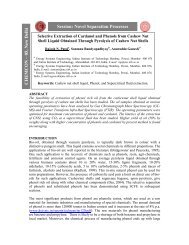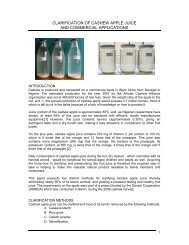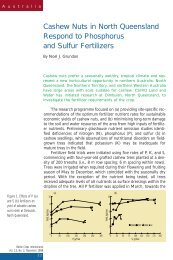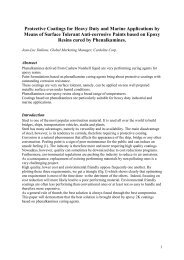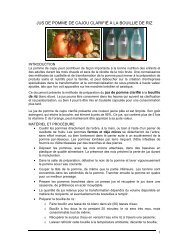CASHEW NUT SHELL LIQUID
CASHEW NUT SHELL LIQUID
CASHEW NUT SHELL LIQUID
You also want an ePaper? Increase the reach of your titles
YUMPU automatically turns print PDFs into web optimized ePapers that Google loves.
<strong>CASHEW</strong> <strong>NUT</strong> <strong>SHELL</strong> <strong>LIQUID</strong><br />
CONTENTS<br />
SECTION I PRODUCT CHARACTERISTICS AND SPECIFICATION<br />
SECTION II PRODUCT APPLICATIONS<br />
SECTION III IMPORT/EXPORT TRENDS<br />
SECTION IV INDIAN MANUFACTURERS<br />
SECTION V PRICE<br />
SECTION VI INDIAN DEMAND<br />
SECTION VII BROAD OUTLINE OF MANUFACTURING PROCESS<br />
SECTION VIII RAW MATERIALS REQUIREMENTS AND AVAILABILITY<br />
SECTION IX GLOBAL SCENARIO<br />
SECTION X DISCUSSIONS ON ECONOMIC CAPACITY,<br />
PROJECT COST AND PROFITABILITY PROJECTIONS<br />
SECTION XI SWOT ANALYSIS<br />
SECTION XII FACTORS INFLUENCING THE POSITION FOR<br />
A NEW INDUSTRY AND RECOMMENDATIONS<br />
1
SECTION I<br />
PRODUCT CHARACTERISTICS AND SPECIFICATION<br />
1.1 General details<br />
Cashewnut Shell Liquid (CNSL) is a reddish brown viscous liquid, having the honey<br />
comb structure of the shell of cahsewnut obtained from cashew tree.<br />
Specifications<br />
1.2.1. Natural CNSL<br />
Anacardic acid 80.9%<br />
Cardol 10-15%<br />
Small amounts of other materials notably the methyl derivatives of cardiol<br />
1.2.2. CNSL extracted with low boiling petroleum<br />
Anacardic acid 90%<br />
Cardol 10%<br />
2
SECTION-II<br />
APPLICATION OF CNSL RESIN<br />
2.1. General Details<br />
Cashewnut Shell oil is extracted from the honey-combed shell of the cashew nut and then<br />
sold in its raw or distilled form into two different markets: auto brake linings and<br />
industrial and marine coatings. In the coatings arena, cashew nut shel oil is used as a key<br />
raw material in the production of curing agents for special epoxy hardeners and epoxy<br />
resins.<br />
Coating sector<br />
Industrial and marine coatings.<br />
Paint (anti corrosive) and enamels, varnishes rubber industry to<br />
enhance the vulcanisate properties.<br />
Lacquers developed from cnsl could be used for insulation,<br />
protective or decorative coatings for furniture, buildings,<br />
automobiles, etc.<br />
In the coating arena, cashewnut shell oil is used as a key raw<br />
material in the production of curing agents for special epoxy<br />
hardeners and epoxy resins.<br />
Construction sector<br />
Laminating industry<br />
Substitute<br />
Automobile<br />
For cementing floors exposed to chemical attack.<br />
For reducing brittleness and improving the flexibility of the<br />
laminates.<br />
As a substitute for linseed oil in the manufacture of foundry<br />
core oil, which is used as a binder in the foundry.<br />
Auto brake lining<br />
3
New applications:<br />
Using cashenut shell liquid, a novel and cheaper liquid crystalline polyester has been<br />
synthesised that can substitute for polymer fibres and films in speciality applications.<br />
Liquid crystalline (lc) polymers have attracted much attention in recent years because of<br />
their potential use as high performance materials.<br />
2.2. Paints and Enamels<br />
Because of its dark colour, CNSL is used in the manufacture of dark coloured paints and<br />
enamels.<br />
A number of anticorrosive paint formulations for ship bottoms have been made by the<br />
Regional Research Laboratory, Hyderabad, the Central Institute of Fisheries Technology,<br />
Cochin, Bombay University and the Research, Design and Standards Organisation,<br />
Lucknow.<br />
Paints and varnishes made from CNSL have superior properties than those of<br />
conventional oils or synthetic resins. Varnishes resistant to water and gasoline have been<br />
made by incorporating sulphur in CNSL.<br />
Lacquers developed from CSNL could be used for insulation, protective or decorative coatings<br />
for furniture, buildings, automobiles, etc. The films have toughness and elesticity, excellent gloss<br />
and superfine adhesive qualities. The dried films are superior to those of ordinary oil paints in<br />
respect of resistance to oils, grease moisture and chemicals. Cashew lacquers are cheaper than<br />
ordinary oil varnishes.<br />
2.3. Electrical Insulating Varnishes<br />
Electrical Insulating varnishes are obtained by treating CNSL with formaldehyde and<br />
compounding the resulting material with pure phenolic resin varnish or alkyd resin in<br />
suitable proportions. Films of those materials are water and chemical resistant and can<br />
be used as insulating varnished with high electrical resistance and as bobbin enamels and<br />
laboratory table tops<br />
2.4. Polymers<br />
Cashew polymers react with formaldehyde to give a rubbery gel, which can be used as a<br />
cement hardening agent that would be immune to acids and alkalies reaction. It can be<br />
used for cementing floors exposed to chemical attack.<br />
CSNL modified by heating at 160 deg.C. in the presence of certain accelerators give<br />
stoving enamels that are resistant to alkali and acid solutions, mineral and fatty oils and<br />
4
various organic solvents. Coating compositions possessing insecticidal properties are<br />
obtained by adding DDT, Gammexane etc., to CSNL or chlorinated CNSL after<br />
treatment with Formaldehyde gums and resins and drying or semi-drying oils.<br />
Apart from the polymeric products, CNSL forms the basic raw material for a vast number<br />
of industrially important chemicals and chemical intermediates. Chlorinated products of<br />
cardanol and hydrogenated cardanol are found to have pesticidal action. The various<br />
components of cardanol can be suitably modified to obtain emulsifiers and surface active<br />
agents, dyestuffs, antioxidants, plasticizers, stabilizers, accelerators, curatives, reclaiming<br />
agents and ion-exchange resins.<br />
2.5. Lamination<br />
CSNL or Cardanol derivatives are extensively used in the laminating industry for<br />
reducing brittleness and improving the flexibility of the laminates.<br />
A CSNL based adehsive for blending concrete to wooden surface has been developed by<br />
the Central Building Research Institute, Roorkee. Adhesives suitable for plywood are<br />
made by oxidising CSNL with potassium permanganate or Manganese dioxide at 100<br />
deg. C reacted with Paraformaldehde and compounded with Cuprous chloride. Also<br />
CSNL modified with furfural, aniline, xylol etc, gives good plywood adhesives.<br />
2.6. Rubber Products<br />
The use of CNSL in rubber compositions has been found to improve the performance of<br />
rubber products. It helps processing and enhances the vulcanizate properties. CNSL<br />
enhances the insolubility of natural rubber vulcanizates in petroleum solvents. It helps<br />
in the incorporation of ingredients into rubber and increases its resistance to moisture.<br />
Oxides of Cu, Ba, Zn, etc. harden CNSL and give hard products.<br />
2.7. Phenoplasts<br />
Cardanol and its derivatives can also be converted to phenoplasts with better<br />
processability, hydrocarbon solubility and resistance to acids and alkalies than the<br />
conventional phenol-based systems. Moulding powders from CNSL, shellac, and fillers<br />
such as wood flour, sawdust, asbestos, etc. are found to give articles with excellent finish,<br />
good flexural and tensile strengths and satisfactory water resistance.<br />
Stable rigid or flexible covering materials in the form of tiles sheets, etc., are made from<br />
compositions containing CNSL, formalin, natural rubber and synthetic rubber and other<br />
conventional ingredients.<br />
Light weight, sandwich type plastics, composite pannels suitable for partitions, claddings,<br />
flush doors etc. Have been developed using resins based on CNSL. Foam plastics based<br />
on CNSL and its derivatives have also been made.<br />
5
The use of CNSL in rubber compositions has been found to improve the performance of<br />
rubber products. It helps processing and enhances the vulcanizate properties.<br />
CNSL enhances the insolubility of natural rubber vulcanisates in petroleum solvents. It<br />
helps in the incorporation of moisture. Oxides of Cu, Ba, Zn, etc. Harden CNSL and give<br />
hard products.<br />
CNSL also finds use in making floor tile laminate resins, oil-cloth finish compositions<br />
and as a rubefacient and vessicant in treating skin diseases and in tropical medicine.<br />
CNSL, is a unique monomer source for unsaturated phenols which can be polymerized to<br />
get various polymeric products can be suitably modified to chemical intermediates for<br />
industrial uses.<br />
2.8. Modified CNSL<br />
The various components of cardanol can be suitably modified to obtain emulsifiers and<br />
surface active agents, dyestuffs, antioxidants, plasticizers, stabilizers, accelerators,<br />
curatives, reclaiming agents and ion-exchange resins.<br />
CNSL modified by heating at 160-300 degC in the presence of certain accelerators give<br />
stoving enamels resistant to alkali and acid solutions, mineral and fatty oils and various<br />
organic solvents.<br />
Coating compositions possessing insecticidal properties are obtained by adding DDT,<br />
gammexane, etc. to CNSL or chlorinated CNSL, after treatment with formaldehyde,<br />
gums and resins and drying or semi-drying oils.<br />
2.9. Derivatives of CNSL<br />
CNSL or Cardanol derivatives are extensively used in the laminating industry for<br />
reducing brittleness and improving the flexibility of the laminates.<br />
2.9.1. Adhesive<br />
A CNSL-based adhesive for blending concrete to wooden surface was developed by the<br />
Central Building Research Institute, Roorkee. Adhesives suitable for plywood are made<br />
by oxidising CNSL with potassium permanganate or manganese dioxide at 100degC<br />
reacted with paraformaldehyde and compounded with CuCl 2 . Also CNSL modified with<br />
furfural, aniline, xylol, etc. gives good plywood adhesives.<br />
2.9.2. Binder in the foundry<br />
CNSL is also used as a substitute for linseed oil in the manufacture of foundry core oil,<br />
which is used as a binder in the foundry.<br />
6
2.10. Basic raw material<br />
Apart from the polymeric products, CNSL forms the basic raw material for a vast number<br />
of industrially important chemicals and chemical intermediates.<br />
2.11 Pesticidal action<br />
Chlorinated products of cardanol and hydrogenated cardanol are found to have pesticidal<br />
action.<br />
2.12. New polyester from cashewnut shell liquid<br />
Using cashewnut shell liquid, a group of scientists have synthesised a novel and cheaper<br />
liquid crystalline polyester that can substitute for polymer fibres and films in specialty<br />
applications.<br />
The team includes a scientist (RRL), Trivandrum, who is on a fellowship at the<br />
University of Strathclyde, Glasgow, United Kingdom, and D.C.Sherrington and A.<br />
Sneddon from Strathclyde. Their work was reported in the journal Polymer.<br />
Liquid crystalline (LC) polymers have attracted much attention in recent years because of<br />
their potential use as high-performance materials. Earlier attempts to prepare the<br />
motropic LC polymers have met with varied success as they yielded products that were<br />
insoluble and could not be easily processed.<br />
Since then, scientists have been attempting to lower the melting point of these polyesters<br />
by various chemical methods to make them easy to process. The Glasgow team<br />
developed a new method using a natural material cardanol obtained from cashewnut shell<br />
liquid (from the plant Anacardium polymer poly (1,4-benzoate-1,3-phenyl octanoate).<br />
Cardanol is similar to phenol except that it has an additional 15-carbon unsaturated<br />
sidechain. Like phenol, cardanol can be polymerised with formaldehyde. It can undergo<br />
a variety of polymerisation reactions and chemical modifications because of the<br />
additional side-chain Earlier studies by Pillai have shown that high-performance and<br />
speciality polymers could be produced from cardanol.<br />
The significance of the new copolyester obtained by Pillai and his Strathclyde colleagues<br />
is that its transition temperature-256degC-is lower than that of two commercially<br />
available LC co-polyesters in the United States. These two polyesters-known in the<br />
market as Vectra and Xyder-have melting points near 300degC and are, therefore,<br />
difficult to process. The cost that of other similar products.<br />
7
2.13. Medicinal applications<br />
Cashew, the king of dry fruits, is not merely the best topping for a delicious last course, it<br />
is also an aphrodisiac that can boast of many curative properties. The latent and benign<br />
medicinal properties of cashew, of which India is the largest producer worldwide, are<br />
enormous, according to research data published by the Cashew Export Promotion<br />
Council of India, at Kochi.<br />
Laden with 21% protein and an equally high percentage of poly unsaturated fatty acids,<br />
cashew helps in reducing the blood cholesterol level considerably preventing possibilities<br />
of heart attacks. With an exceedingly low content of saturated fat and soluble sugar,<br />
cashew could slim down one's waistline. Besides, cashew kernels, rich in calcium,<br />
phosphorous and iron, can help prevent anagemia and nervous system ailments, the<br />
research found. In fact, the vegetable proteins contained in cashew kernels stand at par<br />
with milk, eggs and meat. Besides, it also contains a high concentration of much needed<br />
acids in right proportions, generally very rare in nuts.<br />
A cashew kernel contains 47% fat, 82% of this fat is unsaturated fatty acids. This<br />
unsaturated fatty acids helps in lowering blood's cholesterol level. The most prominent<br />
vitamins in cashew are vitamin A, D and E. These vitamins help in assimilating the fats<br />
and increase the immunity level. Being a rich source of minerals like calcium,<br />
phosphorus and iron, consumption of cashew kernels can help protect the nervous system<br />
as well.<br />
According to the Indian Cashew Journal, an official publication of the Cashew Export<br />
Promotion Council, cashew kernel is very low on carbohydrates-as low as one per cent of<br />
soluble sugar-which means that one is privileged to a sweet taste without worrying about<br />
excess calories. One big property of cashew is that it helps in controlling diabetes, says<br />
the journal.<br />
The recently discovered vitamin-PP also develops when a cashew is roasted, the journal<br />
says, adding that these vitamins exert a sparing action on the B group vitamins and assist<br />
in metabolism of lactose and thiamine. The presence of vitamin E in cahsew takes care<br />
of all reproductive problems and prevents the development of oxidative rancidity in fats.<br />
According to experts, at the council, high content of linoleic acid in cashew kernel makes<br />
it an ideal digestive assimilative stimuli since linoleic acid has a structure best suited to<br />
the synthesis of prostaglandins, the wonder substance found in many body organs and<br />
having a profound influence on various body functions. The process roasting and<br />
toasting kernels assists in increasing these properties.<br />
8
Cashew kernel oil is also considered a good mechanical and chemical antidote for irritant<br />
poisons, and it is a vehicle for linaments and other external applications, experts point<br />
out. The kernel is also used as a substitute for almond mixture, and is a good food for<br />
patients suffering from incessant and chronic vomitting.<br />
One of the most popular systems of Indian medicine, ayurveda also lists quite a few<br />
unique curative properties of Indian cashewnut and prescribes it as a good stimulant,<br />
rejuvenator, appetiser, excellent hair tonic aphrodisiac and restorative. Experts say raw<br />
cashew fruit was used as an anaesthetic in leprosy, and also for curing warts, corns and<br />
ulcers.<br />
The juice of the nut is used as a substitute for iodine while the oil obtained from the shell<br />
is good for cracks in feet. The cashew apple contains 10.44 per cent of fermentable<br />
sugars and 261.5 mg per 100gm of vitamins C, giving both the fruit and the wine made of<br />
it very good antiscorbutic properties. The liquor is also valued as a diuretic with healthy<br />
effect on kidneys and advanced cases of cholera.<br />
Apart from its commercial importance as an intoxicant liquor, cashew feni, very popular<br />
in Goa, is said to have high medicinal value and has for centuries been used by the Goans<br />
as a cure for ailments ranging from worm sickness in children to diahrroea and even<br />
cholera.<br />
9
3.1. Imports: Negligible quantity<br />
SECTION III<br />
IMPORT/EXPORT DETAILS<br />
3.2. Exports<br />
3.2.1. Present exports level of CNSL 1705 tonnes per annum<br />
3.2.1.1. Annual exports of CNSL<br />
1900000<br />
1896800<br />
1850000<br />
1800000<br />
1750000<br />
1700000<br />
1766400<br />
1704565<br />
1650000<br />
1600000<br />
April 1999 to<br />
March 2000<br />
April 2000 to<br />
March 2001<br />
April 2001 to<br />
March 2002<br />
Quantity in Kg<br />
Year<br />
10
3.2.1.2.Countrywise Exports of CNSL<br />
Period April 2001 to March 2002<br />
Country<br />
Quantity in Kgs<br />
Australia 817<br />
Chinese Taipei 200<br />
Japan 109000<br />
Korea DP RP 44500<br />
Korea RP 773600<br />
New Zealand 28<br />
Norway 5000<br />
Slovenia 16000<br />
Spain 1000<br />
U Arab Emts 1000<br />
USA 737420<br />
Zimbabwe 16000<br />
3.2.2. Cashew Shell Liquid (Cardanol) Purified & Distilled<br />
3.2.2.1. Annual exports<br />
11
350000<br />
300000<br />
348950<br />
287883<br />
250000<br />
Quantity in Kg<br />
200000<br />
150000<br />
100000<br />
163682<br />
50000<br />
0<br />
April 1999 to<br />
March 2000<br />
April 2000 to<br />
March 2001<br />
Year<br />
April 2001 to<br />
March 2002<br />
3.2.2.2. Countrywise Exports Details<br />
Period April 2001 to March 2002<br />
Country<br />
Quantity in Kgs<br />
Australia 578<br />
Belgium 20000<br />
France 5<br />
Japan 6000<br />
Korea Rp 104600<br />
U Arab Emts 3000<br />
UK 91700<br />
USA 62000<br />
12
SECTION IV<br />
INDIAN MANUFACTFURERS<br />
There are number of units in small scale sector. The Indian manufacturers of CNSL resin include<br />
the following.<br />
* Anant Chemical Industries,<br />
Factory: B-55, MIDC Paithan,Aurangabad-431 148<br />
Phone : 32161 (02431)<br />
Office : 2 "Chinmay" Apartment<br />
Jyotinagar, Aurangabad-431 005<br />
* Anbu Cashew Chem (P) Ltd.,<br />
2/11, Main Road,<br />
Kadampuliyur-607 103.<br />
B-1/1, Sipcot Industrial Complex<br />
Kudikadu,<br />
Cuddalore 607 005<br />
* Benzochem Industries<br />
Shed No.21, M.I.D.C. (Chemical Zone),<br />
Ambernath 421 501, Dist. Thane<br />
101, Motivilla, 140-C, Azad Road,<br />
13
Vileparle (E), Mumbai-400 057<br />
* Cashew Oils & Resins P.Ltd.,<br />
11/1, Postal Colony, Third St.,<br />
West Mambalam, Chennai 600 033.<br />
Factory : 41, Kilakuppam Road, Kadampuliyur-607 103<br />
Cuddalore Dist.<br />
* Cashitron Industries,<br />
At & Post : Gundbala-581 344.<br />
Tal-Ankola,Uttar Karnataka.<br />
* Cee Sulfones Ltd.<br />
B-7, Rajratan Apartments<br />
Ground Floor, Near Garden<br />
Service Road, Jogeshwari (E),<br />
Bombay-400 060<br />
Factory : Plot No.146-149, Achhad Industrial Estate<br />
Taluka Talasari, Dist-Thane, Maharashtra<br />
* Cashitron Resins Pvt. Ltd.<br />
At & PO: Gundbala - 581 344,<br />
Mumbai Office : S.M. Baleri Associates,<br />
6, Suyog, Gokhale Road (N),<br />
Dadar (W), Mumbai-400 028.<br />
* Jyothi Enterprises<br />
9-4-3, Regimental Bazar,<br />
2nd Floor,Secunderabad-500 025.<br />
Factory<br />
Shed No.43,Phase II,I.D.A.,<br />
Mallarpur,R.R.Dist.<br />
* Mothers Pure Herbs<br />
46/1, Jaraganahalli,<br />
Kanakapura Road,<br />
Bangalore - 560078<br />
* Nayakem Organics Pvt. Ltd.,<br />
Regd. Office : 221,Madhani Estate,<br />
542,Senapati Bapat Marg,<br />
Dadar (W), Mumbai -400 028.<br />
14
* Pearl Synthetics and Chemicals<br />
11, Anupam Hsg. Society,<br />
Shreynagar, Osmanpura,Aurangabad-431 005<br />
Factory : PlotNo.B-28<br />
UdyogmitraCo-op. Indl. Estate,<br />
Gut No.26 (Part) Chitegaon<br />
Tal. Paithan, Dist. Aurangabad<br />
* Rishabh Resins & Chemicals,<br />
15-E & F Sri Venkateswara Co-op<br />
Indl. Estate, Jeedimetla, Hyderabad - 500 055.<br />
* Rasaayan Udyog<br />
Factory: Plot No.196, 213, Sy.No.170<br />
Part Doolapally Village<br />
Via Hakimpet, Secunderabad 500 014.<br />
Office: 5-9-22/41-B, Adarsh Nagar,<br />
Hyderabad 500 463<br />
* Sudarsan Phenomers<br />
PIPDIC Industrial Estate,<br />
Kirumampakkam, Pondicherry-607 402<br />
* Sri Panduranga Industries<br />
Hebri-576 112,.<br />
Phone : 71178/71221 (STD) 08258.<br />
Factory : Shivapura (D.K.)<br />
* Sabarigiri Industries<br />
Post Box No.10,27,Kumbakonam Road,<br />
Panruti-607 106.<br />
* Sathyashree Industries<br />
Kanyana, Hebri 576 112<br />
* Selva Enterprises,<br />
Post Box No.1.<br />
Kayamkulam, Kerala-690 502.<br />
* Swadeshi Resins & Chemicals,<br />
West Hill, Calicut-673 005,Kerala.<br />
Indian installed capacity<br />
20000 tonnes per annum<br />
15
SECTION V<br />
PRICE<br />
Present price level for CNSL : Rs.16,000 per tonne<br />
Taxes and duties : Extra as applicable<br />
17
SECTION VI<br />
INDIAN DEMAND<br />
The demand for CNSL including export demand is estimated to be around 10,000 tonnes<br />
per annum.<br />
The estimated growth rate in demand is 7 to 8% per annum<br />
18
SECTION - VII<br />
MANUFACTURING PROCESS AND TECHNOLOGY SOURCE<br />
7.1. Manufacturing process<br />
Cashewnut Shell Liquid extracted with low boiling petroleum, contains about 90%<br />
Anacardic acid and about 10% Cardol.<br />
Cashewnut shell liquid on distillation, gives the pale yellow phenolic derivative cardanol.<br />
Natural cashewnut shell liquid contains 80% Anacardic acid, 10-15% cardol and small<br />
amounts of other materials notably the methyl derivatives of Cardol.<br />
Many refined extraction techniques have of late been devised.<br />
Expeller method being used in Mangalore area is better than other methods like hot oil<br />
bath method, kiln method, etc. as it extracts 90% of the oil.<br />
19
7.2. Source of technology and Technology developments<br />
Regional Research Laboratory, Tiruvananthapuram<br />
Regional Research Laboratory, Tiruvananthapuram have reported to have developed the<br />
technology for the manufacture of cashewnut shell liquid.<br />
(Council of Scientific & Industrial Research)<br />
Industrial Estate P.O.,<br />
Pappanamcode,Thiruvanthapuram-695 019, Kerala.<br />
Phone EPABX : 0471-490811, 490324, 490674, 490224<br />
Fax : (0471) 490186, 491712, 491895<br />
Telex : 0435-232; Telegram : CONSEARCH<br />
E-mail : rrit@sirnetm.ernet.in, root@csrrltrd.ren.nic.in<br />
rrltm@md2.vsnl.net.in<br />
A new method to prepare a transparent resin from Cashewnut shell Liquid.<br />
Regional Research Laboratory, Tiruvananthapuram is reported to have developed the<br />
technology for the manufacture of Cashew nut shell liquid.<br />
Regional Research Laboratory have synthesised a novel and cheaper liquid crystalline<br />
polyester based on Cashew nut shell liquid that can substitute for polymer fibres and<br />
films in speciality applications.<br />
CSNL's utilisation is restricted due to its colour, as only brown-coloured products can be<br />
prepared from it impending its competitiveness with synthetic resins.<br />
Research is under way at the Regional Research Laboratory (RRL),<br />
Thiruvananthapuram, to evolve a colourless resin from the cashewnut shell<br />
liquid.<br />
The method developed under a sponsored project by Vijayalexmi Cashew Company,<br />
Kollam, could be used to prepare clear coatings and paints of all colours. The coatings<br />
can be used in the electronic and automobile industry, adhesives and polymer support<br />
materials.<br />
The scientists successfully produced polymerisable monomers cardanyl methacrylate<br />
(CMA) which after bulk polymerisation with appropriate chemicals gave polycardanyl<br />
methacrylate.<br />
Evaporation of the solvent gave transparent films and uniform-sized transparent beads<br />
and aqueous emulsions were produced through other methods .<br />
20
* Oil Technological Research Institute,<br />
Jawaharlal Nehru Technological University,<br />
P.B.No.17,Anantapur-515 001. Andhra Pradesh<br />
STD. 08554 Phone:Off.20376<br />
Gram : RESEARCH<br />
* Central Food Technological Research Institute,<br />
Cheluvamba Mansion, Mysore - 570 013.<br />
Tel : 0821-515447, 514534, 513658, 544289<br />
Fax : 0821-515453, 517233<br />
Telefax : 0821-515440<br />
Gram : FOODSEARCH<br />
Telex : 846 241 FTRI IN<br />
E-Mail:<br />
ttm@cscftri.ren.nic.in, ferm@cscftri.ren.nic.in<br />
prakash@nicfos.ernet.in, sspo@cscftri.ren.nic.in<br />
Website : http://www.mylibnet.org.in/cftri/cftri.html<br />
www.cftri.com<br />
21
Major plant and machinery<br />
Name of the equipment<br />
Extractor<br />
Name of the supplier<br />
Adam Fabriwork P. Ltd.,<br />
203, Rajguru Appartments<br />
New Nagardas Road,<br />
Andheri (E), Mumbai-400 069<br />
Super Scientific Works P.Ltd.,<br />
E-70-71, Sardar Estate,<br />
Ajwa Road, Baroda-390 019<br />
Distillation column<br />
Chemac Equipments Pvt. Ltd.<br />
Regd. Office & Factory:<br />
M.J.D'Souza Compound,<br />
Safed Pool, Saki Naka<br />
Mumbai-400 072<br />
Hydrabad Met Chem. Pvt. Ltd.,<br />
34, C.I.E., Phase II,<br />
Gandhinagar, Opp. IDPL Colony<br />
Hyderabad-500 037<br />
Evaporator<br />
Excel Industrial Services<br />
White House, D-111/8,Ist Main Road,<br />
Anna Nagar (East)<br />
Chennai-600 102<br />
Alfa Laval Saunders (India) Ltd.,<br />
No.18, Gill Nagar, Fist Street<br />
Chennai-600 094<br />
Boilers<br />
Cethar Vessels Ltd.,<br />
No.4, Dindigul High Road,<br />
Trichy<br />
Firetech Boilers Pvt. Ltd.<br />
No.211, 2nd Cross,<br />
38th Main, B.T.M. Layout<br />
2nd Stage, Bangalore-68<br />
SECTION VIII<br />
22
RAW MATERIAL REQUIREMENTS AND AVAILABILITY<br />
Botanical name of Cashew: Anacardium occidentale L<br />
Area of growth of Cashew tree<br />
India and Brazil<br />
Coastal areas of Asia and Africa. Mozambique,<br />
Specification of Cashewnut shell<br />
The shell is about 0.3 cm thick, having a soft feathery outer skin and a thin hard inner<br />
skin. Between these skins is the honeycomb structure containing the phenolic material<br />
known as CNSL. Inside the shell is the kernel wrapped in a thin skin known as the testa.<br />
Composition of cashewnut<br />
The nut consists of the following<br />
Kernel 20 to 25%<br />
kernel liquid 20 to 25%<br />
Testa 2%<br />
Others<br />
Rest being the shell.<br />
The raw material for the manufacture of CNSL is the Cashew. The details of the<br />
availability of Cashew is given below :<br />
Over the past 25 years, the area under the Cashew crop has increased with an average<br />
productivity of about 635 kg per hectare. The productivity in Maharashtra is the highest<br />
with 1300 kg. per hectare followed by 1178 kg per hectare in Kerala.<br />
Native to Brazil, the cashew tree grows in the coastal areas of Asia and Africa,<br />
Mozambique, India and Brazil are the main producers of cashewnut and Cashewnut shell<br />
liquid in the world. In India, Kerala tops in area under cashew cultivation followed by<br />
Tamil Nadu, Karnataka and Andhra Pradesh. Other states which produce cashewnut and<br />
Cashewnut shell liquid are Goa, Maharashtra, Orissa, West Bengal, Tripura and<br />
Pondicherry.<br />
The Shell is about 0.3 cm thick, having a soft feathery outer skin and a thin hard inner<br />
skin. Between these skins is the honeycomb structure containing the phenolic material<br />
known as Cashewnut shell liquid. Inside the shell is the kernel wrapped in a thin skin<br />
known as the testa.<br />
During the Eighties, with the implementation of a World Bank-aided project in four<br />
states, namely, Andhra Pradesh, Kerala, Karnataka and Orissa, the farmers became<br />
23
aware of the horticultural practices in cashew cultivation. The production which was 2.1<br />
lakh tonnes during 1983-84, rose steadily to above 4 lakh tonnes in nineties.<br />
Major Cashew producing states<br />
States Area in Production<br />
hectares in tonnes<br />
Kerala 120000 100000<br />
Maharashtra 103500 60000<br />
Andhra Pradesh 124100 500000<br />
Orissa 108600 45000<br />
Karnataka 87000 35000<br />
Tamil Nadu 80500 30000<br />
Goa 52000 25000<br />
SECTION IX<br />
24
GLOBAL SCENARIO<br />
World production of Cashewnuts<br />
Around one million tonnes per annum<br />
Cashews are grown around the world, chiefly within a band 10 degrees north and south of<br />
the equator. Major producers are located in Brazil, India and Africa.<br />
Cashewnut shell liquid is used in almost every automobile in the world. It provides heat<br />
resistance as an additive in brake linings. The product has been around since the 1920s<br />
or 30s.<br />
Worldwide consumption of cashew nut oil by the auto industry is estimated to be about<br />
25000 tonnes per year.<br />
Palmer is the largest buyer worldwide of cashewnut shell liquid, which it processes<br />
further via a separation process.<br />
Cardolite is the largest buyer in North America<br />
Global development<br />
Ciba polymer<br />
In a move to expand its epoxy coatings product offerings, Ciba polymer has signed a<br />
letter of intent with Worcester, Pennsylvania based Palmer International Inc., For the<br />
development of cashew oil and its derivatives. In doing so, it will take on cardolite corp.,<br />
The originator of and leader in Phenalkamine coatings technology.<br />
Globally, Newyork, us based cardolite competes against palmer in the brake linings<br />
business, but has an edge on coating applications. However, its Phenalkamines do<br />
compete against a wide variety of curing agents marketed by Ciba and others.<br />
Three new products<br />
Ciba polymer are now offering three new products based on the cashew nut shell oil and<br />
have begun a number of R&D projects.<br />
Ciba’s alliance with palmer international will benefit both companies. Palmer is one of<br />
north America’s leading suppliers of cashew nut shell oil, which is used to advance the<br />
state of the art in epoxy hardeners.<br />
SECTION X<br />
25
DISCUSSIONS ON ECONOMIC CAPACITY,<br />
PROJECT COST AND PROFITABILITY PROJECTIONS<br />
Economic capacity : 300 tonnes per annum<br />
Project cost : Rs. 65 lakhs<br />
Assessment of project cost<br />
1. Land<br />
S.No. Description Cost<br />
Rs.in lakhs<br />
1.1 Cost of land of one acre at Rs.5 .5 lakh per acre 2.75<br />
1.2 Cost of levelling, laying internal roads/fencing and<br />
0.28<br />
compound wall<br />
2. Building<br />
Subtotal 3.03<br />
S.No. Description Cost<br />
Rs.in lakhs<br />
2.1 Factory building of area 420 sq.m. at Rs.3200/sq.m. 5.12<br />
2.2 Non-factory building of area 50 sq.m.at Rs.4500/sq.m. 2.7<br />
Subtotal 7.82<br />
Cost of Plant & Machinery<br />
S.No. Description Cost<br />
Rs.in lakhs<br />
3.1 Cost of basic plant and machinery 15.5<br />
3.2 Instrumentation and control 1.15<br />
3.3 Pipelines and valves 1.6<br />
3.4 Structurals for erection 0.8<br />
Subtotal 19.05<br />
3.5 Octroi, excise duty, sales tax, etc.at 12% 2.3<br />
3.6 Packaging and insurance charges (2%) 0.38<br />
3.7 Transportation charges (2%) 0.38<br />
3.8 Machinery stores and spares (2%) 0.38<br />
3.9 Foundation charges (2%) 0.38<br />
3.10 Installation charges (2%) 0.38<br />
Total cost of plant and Machinery 23.25<br />
4. Technical know-how fees Rs.2 lakhs<br />
26
5. Miscellaneous fixed assets<br />
S.No. Description Cost<br />
Rs.in lakhs<br />
5.1. Electrification 2.9<br />
5.2. Steam boiler and auxillaries 3.5<br />
5.3. Water storage tank, borewell etc. 0.76<br />
5.4. Fuel storage tank 0.76<br />
5.5. Laboratory equipment 0.43<br />
5.6. Office machinery & equipment 0.76<br />
5.7. Material handling equipment, packaging machinery,<br />
0.76<br />
weigh balance, etc.<br />
5.8. Diesel generator 4.43<br />
5.9. Effluent treatment 1.32<br />
Total 15.62<br />
6. Preliminary & Pre-operative expenses:<br />
S.No. Description Cost<br />
Rs.in lakhs<br />
6.1. Preliminary expenses 0.7<br />
6.2. Pre-operative expenses:-<br />
6.2.1 Establishment 0.55<br />
6.2.2 Rent rates and taxes 0.77<br />
6.2.3 Travelling expenses 1.2<br />
6.2.4 Interest and commitment charges on borrowings 1.85<br />
6.2.5 Insurance during construction period 1.3<br />
6.2.6 Other preoperative expenses and deposits<br />
6.2.7 Interest on deferred payment<br />
Total 6.37<br />
7. Provision for contingency 3.5<br />
8. Working capital margin 3.2<br />
9. Total project cost Rs. 65 1akhs<br />
10. Means of Finance<br />
Promoter's contribution<br />
Term loan from financing institutions<br />
Total project cost<br />
Rs.26 lakhs<br />
Rs.39 lakhs<br />
Rs.65 lakhs<br />
11. Financial statements<br />
27
Cost of production<br />
A Variable cost Rs. in lakhs<br />
Raw material and utilities 9.65<br />
Spares and maintenance 1.4<br />
Selling expenses 2.4<br />
Total variable cost (A) 13.45<br />
B<br />
Fixed cost<br />
Salaries and wages 9<br />
Interest on term loan and working capital loan 8.75<br />
Depreciation 3.73<br />
Administrative expenses 1.44<br />
Total fixed cost (B) 22.92<br />
C. Total cost of production (A+B) 36.37<br />
D. Selling price per kg. (in Rupees) 16<br />
E. Annual sales turnover 48<br />
F. Net profit before tax (E -C) 11.63<br />
G. Breakeven point in % 66.33<br />
28
SECTION XI<br />
SWOT ANALYSIS<br />
Strength<br />
Weakness<br />
Opportunity<br />
Threat<br />
Ready availability of the product<br />
Lack of R&D thrust<br />
Exports<br />
Substitution possibility<br />
29
SECTION XII<br />
FACTORS INFLUENCING THE POSITION FOR A NEW INDUSTRY AND<br />
RECOMMENDATION<br />
India is , the large producer and processor of Cashewnut shell in the world and therefore,<br />
has special advantages with regard to the CNSL industry.<br />
Indian CNSL industry is still operated mostly as small scale units, lacking in R&D thrust<br />
and application development efforts.<br />
The export opportunity for CNSL would substantially improve, if Indian units would<br />
produce various grades of product for meeting the specific requirement of application<br />
sector.<br />
CNSL should be considered as thrust product for export.<br />
30


